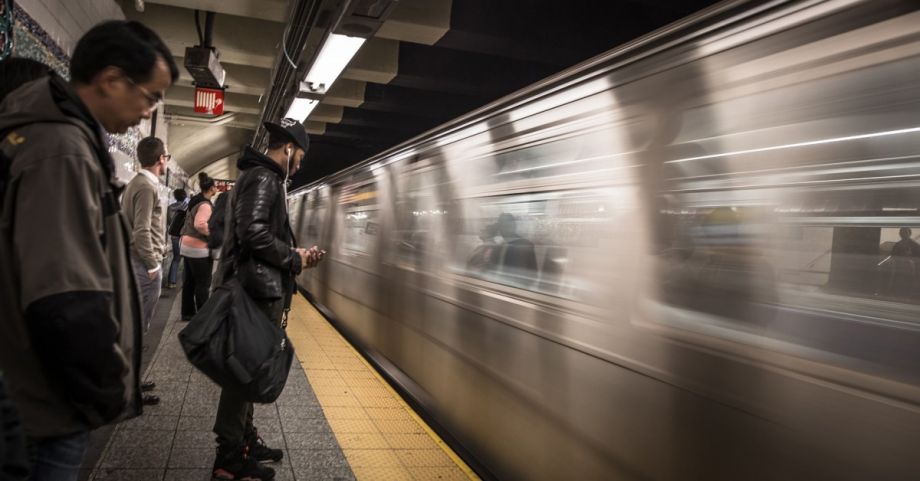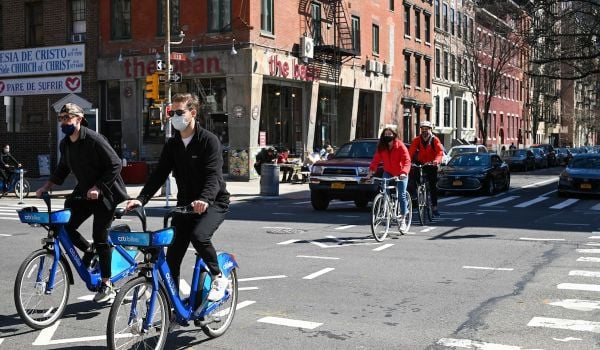Welcome to “The Mobile City,” our weekly roundup of newsworthy developments in urban transportation.
America’s mass transit agencies have been banging the drum loudly for additional coronavirus relief, saying that if they don’t get it when the current round of assistance runs out, both they and their riders will find themselves on the downward slope of the “K-shaped recovery.” As a study of 10 cities finds that more than three million households would lose access to jobs, and more than 1.4 million businesses would lose access to workers and customers, were transit agencies to implement the deep service cuts they say would be necessary without additional relief, a partial COVID-19 relief funding bill passed by the House wraps the aid the agencies seek inside an even more urgently sought payroll protection extension for airline workers. Whether the Senate agrees to the measure, however, is not certain.
Should that calamity come to pass, however, it’s possible that some of those stranded riders might take to two wheels instead. Bike ridership has risen in just about every city since the COVID shutdowns took effect, and new data from a fitness-tracking app shows that it really took off in two cities known for their freeway culture, Houston and Los Angeles.
Meanwhile, on those freeways and on city streets, traffic cops and highway patrols play a major role in maintaining safe travel. As activists have demanded that traffic police departments be broken up and reconstituted in an anti-racist manner, just like the police departments should be, an influential traffic safety organization has endorsed the idea that road safety enforcement needs to get the racism taken out of it too.
More Coronavirus Relief May Be On the Way for Transit
Sept. 30 is the day the current round of coronavirus relief expires. Some transit agencies, like New York’s Metropolitan Transportation Authority, have run through the relief they received under that bill and then some, and they face yawning budget gaps. As the deadline approached, both the New York MTA and the American Public Transportation Association have been issuing increasingly urgent calls for a second round of coronavirus relief, to the tune of $32 billion.
A recent study conducted by TransitCenter and summarized in a Streetsblog USA report finds that upwards of three million households in 10 large U.S. cities and 1.4 million businesses in those same cities would suffer from service cuts once CARES Act funds run out. And, the report finds, many of those hardest hit would be Black, Hispanic and low-income households. Disabled riders would be especially hard hit in Philadelphia, which has the highest concentration of such riders among the cities studied.
The House of Representatives has made another attempt to provide that funding after earlier House-Senate negotiations to extend COVID-19 relief collapsed. Roll Call reports that a House-passed bill that extends payroll protection for airline workers also contains the $32 billon APTA seeks. $28.5 billion of that total would go towards operating expenses. Also included in the bill is $2.4 billion for Amtrak, $569 million of which would go to states to cover state-sponsored train operations and to regional rail operators to help them pay for use of Amtrak’s Northeast Corridor.
According to Roll Call, the House bill is not expected to pass the Senate as written, though. Instead, it’s a bargaining chip to encourage the Senate to re-enter negotiations on a bill that could pass both houses. As the airline assistance in the bill enjoys support in both chambers and from the White House, the Senate will likely take the House up on its offer, but it’s not clear whether the transit funding will survive the negotiations, which are now in overtime.
Data Show Bike Ridership in Houston, LA Going Through the Roof
One silver lining in the COVID-19 cloud is the general rise in bike ridership in the wake of drops in car travel and transit use. Cities across the country have seen growth in bike ridership, but a Bloomberg CityLab article notes that the jumps have been highest in two cities not known as particularly bike-friendly places: Houston and Los Angeles.
Both cities are known for their extensive, and almost perennially packed, freeway networks. But after the COVID-19 shutdowns banned non-essential travel, it appears that many Houstonians and Angelenos turned to bike riding as the way to travel. Data from Strava, a popular fitness tracker, show that 138 percent more bike trips took place in Houston in May 2020 compared to a year earlier. In Los Angeles, the figure for the same month was 93 percent higher than it was the year before. And in contrast to the four other cities for which Strava provided data, bike use in those two cities also rose in April, the first full month of COVID-19 travel restrictions.
A spokesperson for Strava Metro, the division that supplied the data to CityLab, says that users were also logging more trips for essential travel, such as trips to work, school, healthcare facilities and other essential errands. Moreover, a comparison of Strava data with Census Bureau trip data conducted by the U.S. Centers for Disease Control and Prevention found that Strava data reliably reflects what the larger data set reveals.
Cycling experts in the cities themselves say the data match what they see on the ground. Susan Jaworski, a transportation planner for the Hoston-Galveston Area Council, told CityLab, “I think it was the pandemic’s stay-home, stay-safe orders, where people who were remote-working had a chance to discover their bikes” that produced the spike in usage. “When congestion disappeared overnight, I think more folks felt comfortable exploring to get fresh air.”
Eli Akira Kaufman, executive director of the L.A. Bicycle Coalition, said the increase in bike use there might even be higher than the Strava data show, as the data leave out many essential workers who traded bus trips for bike rides. His concern now: getting the city to put the infrastructure in place to make those gains outlast the pandemic. “How do we keep the riding coming?” he said. “That’s the question now.”
State Highway Safety Officials Back Highway Patrol Reform
It appears that calls to “defund the police” extend to the streets and roads too. City police departments also play major roles in enforcing traffic safety laws, and in many states, the primary job of state police agencies is traffic law enforcement, reflected in their being called “highway patrols” instead.
And anyone who has followed reporting on racism in law enforcement should now be aware, one of the places where racial bias comes to the fore is in traffic law enforcement. Stories of “driving while Black” incidents have become common media staples.
Now Streetsblog USA reports that one of the nation’s largest organizations of traffic-safety officials has decided that the time has come to wring the racism out of traffic law enforcement too.
The Governors Highway Safety Association, a nonprofit that advises states, territories and tribal governments on traffic law enforcement and driver education, is encouraging agencies to launch “initiatives to collect and report standardized data about race in traffic enforcement” as part of its latest set of traffic safety recommendations.
A GHSA news release announcing the recommendations includes this statement: “GHSA vehemently condemns racism in all its forms. Race, religion, sexual orientation or any other unique characteristic should never be the reason for a traffic stop, consciously or unconsciously, nor should these characteristics be used to determine who to ticket, who to test, who to search or who to arrest.”
The recommendations also call for state law enforcement agencies to ensure their officer ranks look like the communities they serve. And it urges agencies to collect and analyze data on traffic stops by race and develop ways to eliminate bias in traffic policing based on the data. As of now, only 10 states require the collection of such data, and even fewer use it as a tool for analyzing practices.
But GHSA declined to climb aboard the “defund the police” bandwagon. The release also states, “While GHSA urges reform, we continue to support the proven role of traffic enforcement and the wider criminal justice system to prevent crashes, deaths and injuries; stop dangerous driving; and hold drivers accountable for poor, often deadly, choices. GHSA also supports law enforcement officers who faithfully and equitably implement highway safety programs and risk their lives every day in a dangerous and demanding profession. GHSA vehemently condemns any unprovoked violence towards law enforcement.”
Streetsblog reports that this wasn’t good enough for some antiracism advocates. One such activist, Tamika Butler, told Streetsblog, “It’s just factually not true that police make our streets safer. And if you are someone who has to travel through this world in a Black body, like I am, you are keenly aware of the fact that the only things that are ‘proven’ about law enforcement’s ability to keep anything safe applies to the safety of White people.”
A chart based on National Academy of Sciences research accompanying the quote shows that Black men especially face a much higher likelihood of losing their lives at the hands of police: Almost 1 in every 1,000 Black Americans will be killed by a police officer, compared to only 5 in 10,000 Americans overall. But GHSA executive director Jonathan Adkins told Streetsblog that, say, replacing traffic cops with social workers for drunk-driving stops might make matters worse because more American motorists travel armed than do drivers in countries with unarmed traffic safety officers.
Adkins says he hopes the GHSA’s recommendations will lead to a reduction in that discrepancy. But the activists aren’t holding their breath waiting for that to happen.
Know of a development that should be featured in this column? Send a Tweet with links to @MarketStEl using the hashtag #mobilecity.

Next City contributor Sandy Smith is the home and real estate editor at Philadelphia magazine. Over the years, his work has appeared in Hidden City Philadelphia, the Philadelphia Inquirer and other local and regional publications. His interest in cities stretches back to his youth in Kansas City, and his career in journalism and media relations extends back that far as well.
Follow Sandy .(JavaScript must be enabled to view this email address)




_920_518_600_350_80_s_c1.jpg)











